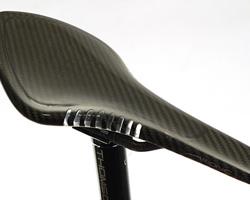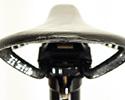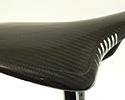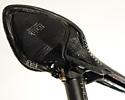
Recently on Cyclingnews.com |
On Test: fi'zi:k Arione k:1 saddle, January 2, 2007
Superlight perch with few compromises

|
fi'zi:k went against the minimalist racing saddle grain in 2003 when it debuted the Arione, a model that was markedly longer, but also a bit heavier than the competition. After spending several seasons introducing iteratively lighter versions, fi'zi:k silences the weight weenie critics once and for all with the cutting edge Arione k:1. Cyclingnews Tech Editor James Huang perches himself atop this newest model to see if any corners were cut in the interest of shaving grams.
In a world where 'lighter is better', fi'zi:k's Arione design was a bit of an oddity. Here was a saddle that was roughly 3cm longer than nearly all of its competitors, but also noticeably heavier, yet few seemed to mind much if the model's popularity is any indication. The extra length provided greater positioning flexibility, fi'zi:k's unique Wing Flex technology actually seemed to work, and the saddle's general shape seemed amenable to the majority of people who plopped themselves down on top of one.
Yet in spite of its functional appeal, the golden rule of bicycle equipment is as unrelenting as ever and fi'zi:k has progressively lightened up its Arione since its introduction with an ever increasing diet of carbon fiber, both in the shell and rails. For 2007, fi'zi:k has completely fallen off of the wagon with its Arione k:1, a nearly 100% carbon fiber creation that plants the new model firmly in the super skinny category with an actual weight of just 152g.
I'll have the carbon, please, with a dollop of gel on top
fi'zi:k's take on the all-carbon saddle is rather unique for a number of reasons. As with some of its competitors, the shell is a one-piece carbon fiber construct (with conspicuously visible carbon weave, of course), but fi'zi'k manages to neatly integrate its effective Wing Flex technology. In this application, the grooves in the shell are dramatically wider and more prominent than in other versions, yet the resultant effect is the same: fi'zi:k claims the feature allows the sides of the saddle to naturally flex in concert with a rider's pedaling motion, making for more efficient power transfer while also minimizing chafing.
Rather than secure a set of conventionally shaped carbon fiber rails underneath the shell, fi'zi:k uses its novel Mobius Braided C4 design. As the name implies, the one-piece design runs in an unbroken loop beneath both the front and rear perimeters of the shell, which fi'zi:k says offers better support and improved reliability.
Careful shaping and engineered flex patterns go a long way towards making all-carbon saddle shells bearable, but there's still little substitute for good old-fashioned padding. In seeking a little cush for its new flagship model, fi'zi:k draws upon the technological expertise of its parent company Selle Royal, arguably the master of melding dissimilar materials in saddle design. The top of the k:1 is covered from tip to tail in a clear co-molded elastomeric "Technogel" polymer which is intended to add an appreciable amount of comfort. The gel is also variable in thickness, with more material applied towards the rear of the saddle where your sit bones would lie. Moreover, the gel also adds some welcome grip to what would otherwise be a notoriously slippery bare carbon shell.
Get it on
There are few surprises in installing the Arione k:1; after all, a saddle is a saddle for the most part, at least in this respect. fi'zi:k thoughtfully equips the extra-long Arione k:1 with a similarly rangy set of rails that provide ample fore-aft adjustment that should enable just about anyone to achieve proper positioning. The braided and wrapped rail construction also lends a little more protection from inadvertent crushing when clamping the saddle. However, users should keep in mind that, in addition to being extra long, the carbon rails are also taller than normal, meaning the Arione k:1 may not fit in some seatpost heads.
Surprise, surprise
In spite of its menacing appearance, the Arione k:1 was actually surprisingly comfortable… to a point. Current Arione users will also be pleased to know fi'zi:k has faithfully reproduced its proven Arione shape in carbon for the k:1, which can be a good and/or bad thing depending on your particular preferences and physiology. As compared to some other saddles on the market, the Arione uses a more traditional shape that is slightly domed through its centerline. Riders that tend to prefer flatter profiles or "anatomic" cutout models may not find the Arione's relatively classic shape to provide enough soft tissue relief.
Regardless, the rear portion of the k:1 provided excellent sit bone support that won't sag over time, and the Technogel cover was deceptively effective even with its minimal thickness. As promised, the Technogel top also kept me from sliding around too much while pedaling but isn't so grippy so as to inhibit free movement. Durability on the innovative co-molded top may be a bit of a concern, though, as the edges of our test saddle began to peel during testing. To be fair, our k:1 was a preproduction sample and fi'zi:k insists that the process had been refined as of production time.
fi'zi:k's Wing Flex feature is also arguably even more effective in this application than on its other so-equipped designs thanks to its more compliant construction, and unlike those other models, there was no break-in period required. As on all Arione models, there is also ample real estate on which to move in order to suit the situation at hand.
Chances are you still won't find many (if any) sponsored pros atop this newest model, though, as that comfort tended to fade after a couple of hours. The Technogel top is very efficient for its negligible volume, but it still only provides minimal padding. Some aches eventually set in on longer rides, particularly when using more sparsely padded shorts. Also, the Arione's well-designed shape was fine for riding on the tops or hoods (at least for me), but the carbon shell isn't particularly flexible. In fact, the middle of the saddle is rather stiff, and the nose is both unyieldingly rigid and virtually completely unpadded. Long stretches in the drops were met with feelings of, um, well… nothing, really (if you know what I mean), and I would be hesitant to recommend the Arione k:1 for a time trial or triathlon unless you also happen to list pulling out your toenails with pliers on your list of "fun things to do".
Yay or nay?
For the most part, cyclists that are happy with their current Arione saddles will likely be pretty satisfied with the k:1, but as always, saddles are a fiercely personal issue so it is critically important to demo them if at all possible. Whether or not it works for you will depend on, well, you.
Regardless, the new Arione k:1 is a striking example of top-notch carbon fiber construction coupled with innovative co-molding technology that results in a reasonably comfortable saddle in spite of its ethereal weight… at least as long as you're not spending too much time in the drops or on aero bars. Long-distance riders will likely seek something with a bit more squish, but those looking to shave every bit of weight will be hard pressed to find a similarly light saddle that makes offers as many features per gram.
Weight: 152g
Price: US$399.99
Pros: Superlight weight, elegant co-molded Technogel padding, innovative
Mobius rail construction, classic Arione shape
Cons: Minimal padding, overly rigid midsection and nose, classic Arione
shape
Cyclingnews rating: ![]()
Photography
For a thumbnail gallery of these images, click here
Images by James Huang/Cyclingnews.com
- The new Arione k:1 from fi'zi:k pairs superlight carbon fiber construction with an innovative co-molded elastomeric gel cover.
- The rear section of the Arione k:1 provides excellent sit bone support, but the middle and nose sections are uncomfortably rigid.
- The Arione k:1 incorporates a co-molded variable-thickness Technogel top that provides a modicum of comfort (and grip) without adding too much unnecessary weight.
- The Mobius Braided C4 carbon fiber rail system runs completely uninterrupted and fully supports the front and rear perimeters of the saddle while avoiding the common failure points.
- A braided carbon wrap protects the rails from clamp damage. fi'zi:k's trademark Wing Flex technology is plainly visible through the clear Technogel top.
- Our proproduction test sample started to peel a bit at the edges, but fi'zi:k insists the process has been perfected for production.






